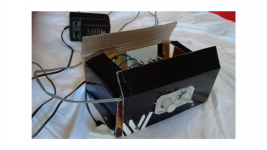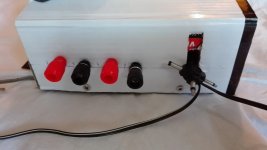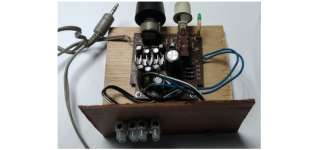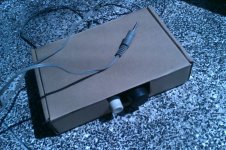Second Prototype Completed
Fixed the board in an enclosure of cardboard to do a trial on installing and fixing connections : power, speaker outs etc. The function of a prototype is to fail. So here it is.
It did not work too well with my full range desktop set up, so I went ahead and connected it to the Sony SS-333 speaker only left speaker to start.
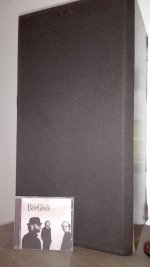
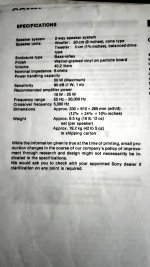
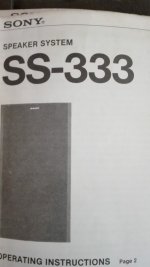
With digital streaming material it sounded good, with the vinyl to CD recording I have the recording sounds a little limited. Overall I was very pleased, and the fact that the ES is a two way with a tweeter really balanced the bass- heaviness of the little amp.
Bottom line is I could listen to this forever.
It was not long ago that I used to gaze at advertisements in Stereo review, wondering when I could buy a $100 amplifier and some speakers.
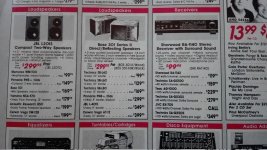
Well the speakers need to be good, but I am jut amazed that I am listening on an amp that cost virtually nothing, and enjoying music so much. I really pleased with this more than the Lepai- type I purchased for around $30 a year back.
I took about 5 minutes to sit down and contemplate the journey that has led me to almost where I want to be. All that wasted time.
Next is to complete my 2 way speakers that I can set at ear level.
Fixed the board in an enclosure of cardboard to do a trial on installing and fixing connections : power, speaker outs etc. The function of a prototype is to fail. So here it is.
It did not work too well with my full range desktop set up, so I went ahead and connected it to the Sony SS-333 speaker only left speaker to start.



With digital streaming material it sounded good, with the vinyl to CD recording I have the recording sounds a little limited. Overall I was very pleased, and the fact that the ES is a two way with a tweeter really balanced the bass- heaviness of the little amp.
Bottom line is I could listen to this forever.
It was not long ago that I used to gaze at advertisements in Stereo review, wondering when I could buy a $100 amplifier and some speakers.

Well the speakers need to be good, but I am jut amazed that I am listening on an amp that cost virtually nothing, and enjoying music so much. I really pleased with this more than the Lepai- type I purchased for around $30 a year back.
I took about 5 minutes to sit down and contemplate the journey that has led me to almost where I want to be. All that wasted time.
Next is to complete my 2 way speakers that I can set at ear level.
Attachments
Last edited:
The reason I halted the project was due to the failure of one channel on the TEA 2025 based PC speaker amplifier. With a little time on my hands I decided to try to repair it.
Output was low or nonexistent on each side. I checked the output capacitors and they seem to be OK using a voltmeter test. They are the only thing between the speaker out and the out pin on the chip, so either there was a problem with the chip, or:
I experienced problems with the input connector the mini RCA jack - no sound was forthcoming until I rotated the jack. Could it be a problem with the input chord or the jack? I immediately checked for continuity on the mini RCA jack to the input solder on the board. One channel showed continuity the other did not. Broken wire?
Finally I hooked up the amplifier and worked through the input wire, twisting and bending it: right in the middle I found a discontinuity, and when held just right, I had full sound on the previous 'bad' channel.
OK so next step is to build a better case for the thing.
Output was low or nonexistent on each side. I checked the output capacitors and they seem to be OK using a voltmeter test. They are the only thing between the speaker out and the out pin on the chip, so either there was a problem with the chip, or:
I experienced problems with the input connector the mini RCA jack - no sound was forthcoming until I rotated the jack. Could it be a problem with the input chord or the jack? I immediately checked for continuity on the mini RCA jack to the input solder on the board. One channel showed continuity the other did not. Broken wire?
Finally I hooked up the amplifier and worked through the input wire, twisting and bending it: right in the middle I found a discontinuity, and when held just right, I had full sound on the previous 'bad' channel.
OK so next step is to build a better case for the thing.
One question: output capacitors - should I consider changing them for better bass? Right now they are: 470 uF.
http://yehar.com/blog/wp-content/uploads/2010/10/TEA2025B.pdf
Edit: can my speakers do 80Hz?
Output Capacitors. The low cut off frequency due to output capacitor depending on the load is given by: FL = 12ΠCOUT•RL with COUT 470μ F and RL = 4 ohm it means FL = 80 Hz.
http://yehar.com/blog/wp-content/uploads/2010/10/TEA2025B.pdf
Edit: can my speakers do 80Hz?
Last edited:
OK so next step is to build a better case for the thing.
Yes ... FWIW ... putting heat producing devices inside flammable containers is a genuine bad idea.
You know I have often wondered about that. Many commercial Hi-Fi amplifiers and stereo systems come with a chipboard back panel and anyway with plastic cases. I wonder if they have ever caught fire:
Ummm. I could do better than this. How to test for ultrasonics and filter them?
This came up on Google search, search term "stereo system catches fire"
Defective Sony stereo is a fire hazard that drives your dog nuts | Engadget
Ummm. I could do better than this. How to test for ultrasonics and filter them?
This came up on Google search, search term "stereo system catches fire"
Defective Sony stereo is a fire hazard that drives your dog nuts | Engadget
Cardboard enclosure...
I finally caved in and found a good cardboard box that my replacement computer adapter came in, and in 45 minutes or so had cut the holes and installed most of the wires required to make this a reality. I added the rubber supports today, and finished up the wiring.
Lessons learned:
1. Obtain a professionally made box or get the box sides cut out professionally and correctly
2. Quickly and neatly drill out the holes and openings required - have the tools and techniques available beforehand.
There are quite a few cardboard housings for electronics including the raspberry Pie. There are also wooden casing which I find an nice option.
I finally caved in and found a good cardboard box that my replacement computer adapter came in, and in 45 minutes or so had cut the holes and installed most of the wires required to make this a reality. I added the rubber supports today, and finished up the wiring.
Lessons learned:
1. Obtain a professionally made box or get the box sides cut out professionally and correctly
2. Quickly and neatly drill out the holes and openings required - have the tools and techniques available beforehand.
There are quite a few cardboard housings for electronics including the raspberry Pie. There are also wooden casing which I find an nice option.
Attachments
The latest prototype. I know it has taken years, but at last a presentable enclosure for the TEA 2025. The case is made out of cardboard, from a box, hardboard or metal would have been more suitable and not too difficult to construct, however the latter two materials are not available to me right now, nor the tools to work on them. The corrugated cardboard box is covered with vinyl sticker paper of light wood finish.
I am very pleased with the finish of the case, fireproofing concerns and long term durability will be a concern.

I am very pleased with the finish of the case, fireproofing concerns and long term durability will be a concern.
I found one of these. The TEA2025 suits little full range speakers, and bookshelf speakers, in room sizes like Bedroom, Kitchen, Office, and other nearfield uses.
TEA2025 (classic PDIP pinout) bass tuning: At feedback pins 6 and 11, a 10 Ohm series resistor can be added for lower gain; and, the 100uF caps (C10,C11) can be increased for cleaner bass tonality (as needed for speaker or eq compatibility).
The datasheet schematic is a fun study in old-fashioned warm sound harmonics efficiency tuning for portable audio; however, if it were used as a home hi-fi and/or if it were used with a baxandall (bass-n-treble dials), we might explore adjusting it to fit the slightly different use.
TEA2025 (classic PDIP pinout) bass tuning: At feedback pins 6 and 11, a 10 Ohm series resistor can be added for lower gain; and, the 100uF caps (C10,C11) can be increased for cleaner bass tonality (as needed for speaker or eq compatibility).
The datasheet schematic is a fun study in old-fashioned warm sound harmonics efficiency tuning for portable audio; however, if it were used as a home hi-fi and/or if it were used with a baxandall (bass-n-treble dials), we might explore adjusting it to fit the slightly different use.
This was settled 7 years ago. Why did you wait this long to object?TEA2025? WHY?? You disappointed me.
True. However, it is good for an exhibit.My point was today you have much better alternative than TEA2025...
I find it fascinating that TEA2025 has documented outdoor prosound tuning in miniature scale. The warm sound effect (2nd harmonic bass, aka foldback) is not located inside of the chip. The location of that effect and how to tune it, is in the datasheet.
With the datasheet suggestion, the warm sound is for 'leveling' the 3" and 4" economy speakers of the radiotape boom-box, and also so that you would be able to hear bass at a longer distance. This tuning could be altered to support other speakers, indoor non-portable use, and to make it compatible with a baxandall.
Interested in that, but the datasheet I found says nothing about itThe warm sound effect (2nd harmonic bass, aka foldback) is not located inside of the chip. The location of that effect and how to tune it, is in the datasheet.
With the datasheet suggestion, the warm sound is for 'leveling' the 3" and 4" economy speakers of the radiotape boom-box, and also so that you would be able to hear bass at a longer distance. This tuning could be altered to support other speakers, indoor non-portable use,
https://www.digikey.com/htmldatashe...TA-dR82EjGcMjHdRXCaSQ7OkfD3lgygkaAtekEALw_wcB
would be so kind as to point to the proper one?
There's a rough-cut edit to the datasheet on the page where they mention feedback, gain and associated RC frequency of 32Hz.
It seems that we can put, up to a 12 ohm resistor series (probably 10r), and use a larger capacitor if cleaner 'less warm' effect were desired.
They didn't say it plainly with words, but almost like charades:
The example schematic cause the warm 90's boom box sound (sounds like Aiwa), precisely (no accident).
The gain discussion mentions the tuning by means of a tiny algebraic mess (as per usual for datasheets).
Ever turn the bass knob on a baxandall (bass-n-treble) dial and got more warm boomy noise instead of the bass that you wanted? TEA2025 can do that because of the datasheet, not because of the chip. I got the little amp to learn how to do this kind of tuning on purpose, so that I'd never again do it by accident.
It seems that we can put, up to a 12 ohm resistor series (probably 10r), and use a larger capacitor if cleaner 'less warm' effect were desired.
They didn't say it plainly with words, but almost like charades:
The example schematic cause the warm 90's boom box sound (sounds like Aiwa), precisely (no accident).
The gain discussion mentions the tuning by means of a tiny algebraic mess (as per usual for datasheets).
Ever turn the bass knob on a baxandall (bass-n-treble) dial and got more warm boomy noise instead of the bass that you wanted? TEA2025 can do that because of the datasheet, not because of the chip. I got the little amp to learn how to do this kind of tuning on purpose, so that I'd never again do it by accident.
Ok, thanks 
I half expected some nonlinear trick asymmetrically distorting low frequencies, which is a way to create low order even harmonics which sound "fat"
Agree that Sanyo, Aiwa, even Sony, artificially create "Bass" in their low cost products.
I was always surprised at small cabinets used as background music in bars, restaurants, shopping malls, etc. putting out "impressive" Bass out of shoebox sized plastic cabinets, with 3" to 6" speakers, tiny magnets, WTF????
Until I browsed schematics (thanks Elektrotanya ) and saw the sorcery behind, from something like you mention to full fledged dedicated ICs such as MaxxBass
) and saw the sorcery behind, from something like you mention to full fledged dedicated ICs such as MaxxBass
Oh well.
I half expected some nonlinear trick asymmetrically distorting low frequencies, which is a way to create low order even harmonics which sound "fat"
Agree that Sanyo, Aiwa, even Sony, artificially create "Bass" in their low cost products.
I was always surprised at small cabinets used as background music in bars, restaurants, shopping malls, etc. putting out "impressive" Bass out of shoebox sized plastic cabinets, with 3" to 6" speakers, tiny magnets, WTF????
Until I browsed schematics (thanks Elektrotanya
Oh well.
The type of warm sound bass for TEA2025 applies to most (all?) voltage feedback amplifiers.
The effect isn't inside the chip, but is inside the datasheet (the suggested schematic).
It has a good example of traditional flea-power amplifier sport (if used with specific speakers).
For most amplifiers, usually, the warm sound bass goes wrong and causes frustration, such as:
Bass knob doesn't work pleasantly (wrong pitch boomy), and/or
Would like bigger input caps but the try was unpleasant (muddy blur), and/or
Speaker compatibility (if done properly, the effect is tuned to 1 specific speaker).
This is an ordinary standard feature of voltage amplifiers, present when there is gain and difference between + and - inputs. Especially noteworthy on websites dedicated to finding the best + input cap while ignoring or omitting the - input cap: For the - input cap (on ordinary non-inverting amplifier) too small (rc freq too high) makes booms (no rumbles, eq frustrate). . . or . . . too big (rc freq too low) makes thuds (no impact, poor dynamics); however, equal amounts of both booms and thuds will cancel bass distortion. So, we'd probably want the right size cap.
Basically, if we wanted a bigger + input cap, then bigger - input cap is also required so that the difference (warm sound) doesn't increase.
P.S. Cold bass effect and psychoacoustic bass harmonic extension
I haven't seen the dedicated bass processing chips; however, to do it in analog, you'd use a 'cousin of baxandall' so the treble can be put through unscathed, and then add clear/thin bass harmonics to the bass channel, to be mixed back together by inverting buffer (mixer adder). . . also having blocked some of the lower bass fundamental tones that full-range speakers cannot produce without also physically shaking/scrambling higher frequencies from that same speaker cone. The initial result is clean, tinny, thin-sounding bass, and pretty good treble (unscathed by bass processing, And unscathed by mad cone excursions).
To hide that thin bass processing sound (and now, the rest of the story): The power amplifier can be creatively set (like TEA2025) to warm up the thin/tinny sound as per ordinary/traditional flea-power amplifier sport.
. . . or a bi-amp method is much easier, to haywire the inputs of a bridge amp so that they interreact for harmonic woofer fun, but also use separate non-bridge amp for the treble (standard on NXP's larger class D amplifiers--try it bridged for your subwoofer).
The analog means may have been forgotten over time, since the more modern products use a DSP. Evenso, it could be very limiting to 'fix' a problem with a DSP if that problem was not located at the same spot.
Historic: Bass harmonic extension became more commonplace after Bing Crosby promoted high resolution tape recording; so, it isn't new. The thing is, those little am kitchen radios that everyone had back then, also had little 4" full range speakers (and the car too); so broadcasters added hear-able bass harmonic at the radio station. Then as today, bass harmonic extension is all about fitting the expectations into little speakers.
Power sound Hazard!
A terrible problem is possible if the SVR cap is missing (TDA7293, LM3886, TDA2030, TDA7297). The hazard is that 'fix at wrong spot' is a limit/barrier to higher performance (the wrong spot fix has to be removed before further progress is possible). In that way, it is bad to try to 'tune out' warm power supply influence by using the difference between + and - inputs. Like the bass knob problem, that can lead to frustration.
Some amplifiers have the SVR cap for immunity, such as TEA2025, C3 & Honey Badger C11,15 & Lineup 3T headphone amp, the big rc on top of the input. . . and so those are easier to power and more straightforward than. . .
However, these, TDA7293, LM3886, TDA2030, TDA7297, require a series element that doesn't dump the bass (so, not a resistor); a cable is insufficient isolation, a regulator works but a diode will do... the series element isolates the ~330u small signal power away from the ~10,000u power reservoir so that the small signal doesn't mix with the power noise and speaker currents in the 10,000u power reservoir (also 330u directly parallel with 10,000u may sound awful; so an isolator between them could sound better). We need an effective series element so that the small signal isn't mixed with warm sounding muck.
Or in other words: (per each channel)
LM3886/TDA7297 470u > 10A100V* > 10,000u
TDA7293/TDA2030 220u > 10A100V* > 10,000u
*isolator can be either high-current-low-voltage diode, or a regulator
Optionally, an ideal bypass for the 470u or 220u is an additional+identical cap (reduces inductance to half).
The 10A100V diode isolation is more convenient and more effective than endless search for best sounding dc cable.
As seen with TDA7297 separate left-right power pins, 470u//470u > Diode isolation, individually per each channel, also blocks stereo crosstalk distortion.
Anyhow, SVR cap, or diode isolator or regulator is needed to reduce power supply influence before fine tuning the amplifier.
Current drive
That's the last item on the list of bass voicing, which serves to flatten the speaker peak as well as fit bass in smaller boxes, like the Minimus 7 when the matching amplifier's 'system' switch is in the on position. Partial current drive is an easier smaller-scope version that matches a broader variety of speakers. Even a few db will cost amplifier power too severely for TEA2025; but, TDA2003 is plenty (that singleton input directly matches phone/pc/tablet so easily), Or TDA2030 is excessively powerful for the job (for indoor in-home use). We might not realize owing several TDA2030, but the fake 5 pin chips are same/similar design, and can use TDA2030's delightful datasheet with practical applications illustrated. Except that they didn't illustrate partial current drive. I've no idea how to do that, but it was worth a mention to complete the list.
Perhaps the point of this post is to list the several different types and locations for bass voicing, so that any optimizations can be done as close as possible to the physical location effective for it, for the purpose of reduced distortion. . . at the speaker.
When I listed one location to do it, I saw trouble, because we wouldn't want to adjust there if the need/problem was at a different physical location in the circuit.
The effect isn't inside the chip, but is inside the datasheet (the suggested schematic).
It has a good example of traditional flea-power amplifier sport (if used with specific speakers).
For most amplifiers, usually, the warm sound bass goes wrong and causes frustration, such as:
Bass knob doesn't work pleasantly (wrong pitch boomy), and/or
Would like bigger input caps but the try was unpleasant (muddy blur), and/or
Speaker compatibility (if done properly, the effect is tuned to 1 specific speaker).
This is an ordinary standard feature of voltage amplifiers, present when there is gain and difference between + and - inputs. Especially noteworthy on websites dedicated to finding the best + input cap while ignoring or omitting the - input cap: For the - input cap (on ordinary non-inverting amplifier) too small (rc freq too high) makes booms (no rumbles, eq frustrate). . . or . . . too big (rc freq too low) makes thuds (no impact, poor dynamics); however, equal amounts of both booms and thuds will cancel bass distortion. So, we'd probably want the right size cap.
Basically, if we wanted a bigger + input cap, then bigger - input cap is also required so that the difference (warm sound) doesn't increase.
P.S. Cold bass effect and psychoacoustic bass harmonic extension
I haven't seen the dedicated bass processing chips; however, to do it in analog, you'd use a 'cousin of baxandall' so the treble can be put through unscathed, and then add clear/thin bass harmonics to the bass channel, to be mixed back together by inverting buffer (mixer adder). . . also having blocked some of the lower bass fundamental tones that full-range speakers cannot produce without also physically shaking/scrambling higher frequencies from that same speaker cone. The initial result is clean, tinny, thin-sounding bass, and pretty good treble (unscathed by bass processing, And unscathed by mad cone excursions).
To hide that thin bass processing sound (and now, the rest of the story): The power amplifier can be creatively set (like TEA2025) to warm up the thin/tinny sound as per ordinary/traditional flea-power amplifier sport.
. . . or a bi-amp method is much easier, to haywire the inputs of a bridge amp so that they interreact for harmonic woofer fun, but also use separate non-bridge amp for the treble (standard on NXP's larger class D amplifiers--try it bridged for your subwoofer).
The analog means may have been forgotten over time, since the more modern products use a DSP. Evenso, it could be very limiting to 'fix' a problem with a DSP if that problem was not located at the same spot.
Historic: Bass harmonic extension became more commonplace after Bing Crosby promoted high resolution tape recording; so, it isn't new. The thing is, those little am kitchen radios that everyone had back then, also had little 4" full range speakers (and the car too); so broadcasters added hear-able bass harmonic at the radio station. Then as today, bass harmonic extension is all about fitting the expectations into little speakers.
Power sound Hazard!
A terrible problem is possible if the SVR cap is missing (TDA7293, LM3886, TDA2030, TDA7297). The hazard is that 'fix at wrong spot' is a limit/barrier to higher performance (the wrong spot fix has to be removed before further progress is possible). In that way, it is bad to try to 'tune out' warm power supply influence by using the difference between + and - inputs. Like the bass knob problem, that can lead to frustration.
Some amplifiers have the SVR cap for immunity, such as TEA2025, C3 & Honey Badger C11,15 & Lineup 3T headphone amp, the big rc on top of the input. . . and so those are easier to power and more straightforward than. . .
However, these, TDA7293, LM3886, TDA2030, TDA7297, require a series element that doesn't dump the bass (so, not a resistor); a cable is insufficient isolation, a regulator works but a diode will do... the series element isolates the ~330u small signal power away from the ~10,000u power reservoir so that the small signal doesn't mix with the power noise and speaker currents in the 10,000u power reservoir (also 330u directly parallel with 10,000u may sound awful; so an isolator between them could sound better). We need an effective series element so that the small signal isn't mixed with warm sounding muck.
Or in other words: (per each channel)
LM3886/TDA7297 470u > 10A100V* > 10,000u
TDA7293/TDA2030 220u > 10A100V* > 10,000u
*isolator can be either high-current-low-voltage diode, or a regulator
Optionally, an ideal bypass for the 470u or 220u is an additional+identical cap (reduces inductance to half).
The 10A100V diode isolation is more convenient and more effective than endless search for best sounding dc cable.
As seen with TDA7297 separate left-right power pins, 470u//470u > Diode isolation, individually per each channel, also blocks stereo crosstalk distortion.
Anyhow, SVR cap, or diode isolator or regulator is needed to reduce power supply influence before fine tuning the amplifier.
Current drive
That's the last item on the list of bass voicing, which serves to flatten the speaker peak as well as fit bass in smaller boxes, like the Minimus 7 when the matching amplifier's 'system' switch is in the on position. Partial current drive is an easier smaller-scope version that matches a broader variety of speakers. Even a few db will cost amplifier power too severely for TEA2025; but, TDA2003 is plenty (that singleton input directly matches phone/pc/tablet so easily), Or TDA2030 is excessively powerful for the job (for indoor in-home use). We might not realize owing several TDA2030, but the fake 5 pin chips are same/similar design, and can use TDA2030's delightful datasheet with practical applications illustrated. Except that they didn't illustrate partial current drive. I've no idea how to do that, but it was worth a mention to complete the list.
Perhaps the point of this post is to list the several different types and locations for bass voicing, so that any optimizations can be done as close as possible to the physical location effective for it, for the purpose of reduced distortion. . . at the speaker.
When I listed one location to do it, I saw trouble, because we wouldn't want to adjust there if the need/problem was at a different physical location in the circuit.
The bass harmonic extension aka cold bass can't be felt through the floor. At best, the wee speakers manage a presentation almost like headphones....I was always surprised at small cabinets used as background music in bars, restaurants, shopping malls, etc. putting out "impressive" Bass out of shoebox sized plastic cabinets, with 3" to 6" speakers, tiny magnets, WTF????...
So, I wondered if W-King and their intense sharp focus on good sounding portable speakers (with no other features), might have used some analog means? Because, I can feel that! I suppose there is actually real bass. You can feel it.
I got one because (the rest of the story), in 1979, I saw RC man zoom past on classic roller-skates, stripey tube socks, football shorts, half a shirt, salad bowl haircut, and an olive-color GE Loudmouth II blasting the 8 track on his shoulder. For this observation, I thought he's doing it right.
So, I got a W-King D8 in olive color. Their focus on best portable speaker worked, but at cost of features. I have to push a rubber button per each use. I have to push the button curiously to pair with phone, and this involves referring to instructions per each use. That does save battery! The really good speaker is focused to only speaker; so, it doesn't have TF Shuffle player aboard and it doesn't have radio aboard. That seems to have been the cost of sharp focus on #1 excellent portable speaker. It certainly does do that. But, it doesn't do anything else.
Unfortunately, I'm kinda daft, so I forgot the point of this post. Sorry about that!
- Home
- Amplifiers
- Chip Amps
- New Sleek Chip amp project
